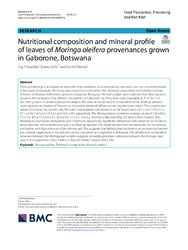| dc.contributor.author | Masitlha, Eng P. | |
| dc.contributor.author | Seifu, Eyassu | |
| dc.contributor.author | Teketay, Demel | |
| dc.date.accessioned | 2024-02-01T08:02:36Z | |
| dc.date.available | 2024-02-01T08:02:36Z | |
| dc.date.issued | 2024-01-04 | |
| dc.identifier.citation | Masitlha, E. P., Seifu, E., & Teketay, D. (2024). Nutritional composition and mineral profile of leaves of Moringa oleifera provenances grown in Gaborone, Botswana. Food Production, Processing and Nutrition, 6(1), 3. | en_US |
| dc.identifier.issn | 26618974 | |
| dc.identifier.uri | 10.1186/s43014-023-00183-8 | |
| dc.identifier.uri | https://link.springer.com/article/10.1186/s43014-023-00183-8 | |
| dc.identifier.uri | https://hdl.handle.net/13049/727 | |
| dc.description | This is an open access article, open to all with no access fees. | en_US |
| dc.description.abstract | Although Moringa is an important vegetable crop elsewhere, its nutritional and non-food uses are not widely known in Botswana community. This study was conducted to determine the chemical composition and mineral contents of leaves of Moringa oleifera trees grown in Gaborone, Botswana. The leaf samples were collected from Moringa trees grown in the backyards of six different households in Gaborone city. They were dried separately at 55 ºC for 24 h and then ground to obtain a powder for analysis. The data on the proximate composition of the Moringa samples were subjected to Analysis of Variance to determine statistical differences among the mean values. The overall mean values of moisture, fat, protein, ash, fiber and total available carbohydrates of the leaves were 6.93 ± 0.16, 7.78 ± 0.13, 27.1 ± 0.43, 7.34 ± 0.31, 9.1 ± 1 and 46.5 ± 3%, respectively. The Moringa leaves contained average values of 520 ± 96.0, 7.7 ± 1.3, 30.1 ± 15.5, 0.8 ± 0.1, 82.6 ± 6.4, 1.7 ± 0.2, 1.6 ± 0.2 and 0.02 ± 0.00 mg/100g of Calcium, Iron, Sodium, Zinc, Magnesium, Aluminum, Manganese and Chromium, respectively. Significant differences were observed for moisture, fat, protein and ash contents among the six Moringa samples. The results showed that the leaves are rich in nutrients, particularly with high amounts of protein and ash. This suggests that Moringa leaf could serve as an important protein and mineral supplement in the diet and can be consumed as a vegetable in Botswana. The difference in composition observed between the Moringa leaf samples suggests a possible genotypic difference between the Moringa trees used in this experiment. Thus, there is a need for further study to verify this. Graphical Abstract: [Figure not available: see fulltext:} | en_US |
| dc.language.iso | en | en_US |
| dc.publisher | BioMed Central Ltd | en_US |
| dc.relation.ispartofseries | Food Production, Processing and Nutrition;6(1), 3 | |
| dc.subject | Mineral content | en_US |
| dc.subject | Moringa oleifera | en_US |
| dc.subject | Proximate composition | en_US |
| dc.title | Nutritional composition and mineral profile of leaves of Moringa oleifera provenances grown in Gaborone, Botswana. | en_US |
| dc.type | Article | en_US |

